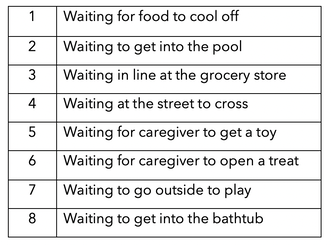|
Waiting is an essential coping skill all children should learn. Teaching a child to wait is also a replacement skill for a wide range of problem behaviors typically demonstrated in young children. What I mean by this is: when a child is required to wait or cannot gain immediate access to something they want, they may tantrum, protest, cry, whine, or even become aggressive. This reaction becomes a habit and typically works well for hurrying the caregiver to respond faster and deliver what is wanted sooner than if they did not engage in the problem behavior. Unfortunately, in the long-term, this does not pay off for the child or the caregiver because it can develop into a dysfunctional relationship. It is best to start teaching a child to learn to wait when they are young because the longer this dysfunction is allowed to occur, the stronger the problem behavior becomes, gaining permanence in the child's coping skills. Regardless, even if you and your child have an extensive history of this cause-and-effect relationship, my recommendation is to start changing it now, but to use more gradual and systematic steps towards change. The best approach to teaching children to wait is to teach and practice waiting in simulated learning trials.
So now we know what waiting looks like, but for how long should we expect a child to wait for what is wanted? Basically, our end goal for is different for every child and every situation because the requirements for waiting vary across the millions of scenarios a child may encounter. But don’t get overwhelmed! Start small, and with each session of practice exercises you will increase your child’s tolerance to waiting. Selecting Reinforcers If you do not know what your child's reinforcers are, present several items on the table and ask them to choose which one they want. You can present some items that you know they already like along with items that you are not sure they will want just to see what they like most. Using media or iPads to teach waiting can be especially challenging because screens tend to be triggers for problem behaviors and kids do not like their movies or iPads turned on and off to do practice trials. I would target teaching them to “wait” for that initial use of the day but don’t turn them on and off while asking them to wait every time, as it is likely to cause a lot of frustration. Similarly, you don’t want to use a reinforcer that you have to take away, as this can also be very frustrating. Instead, choose toys and activities that have natural end to them or at least those which allow you to control when they start or stop. Download our free Reinforcer Checklist if you need some ideas. Target Behavior: Stopping before taking what is wanted or engaging in a desired activity and waiting until an adult allows access without demonstrating problem behaviors. Instructions:
Troubleshooting What do you do if your child grabs the item or starts doing the activity before the count is done? Simply say "no," or "try again," block further access, and start again from the beginning. If your child is struggling, decrease the amount of the time they have to wait so that they are successful. Each time your child is successful, their ability to wait is strengthened. The more successes, the better! Vary the items and activities your child will be required to "wait" for and choose different timing methods (count on fingers and timers) so they don't get stuck on one approach. You want the your child to know that they can wait for many different activities and items in many different conditions. Take Data! When you are working on a program such as waiting, it is a good idea to record some data on your child's behavior so that you can see their progress. When taking data, write down how long your child was able to wait without problem behaviors. It is also a good idea to write down whether your child engaged in any problem behaviors such as crying, protesting, grabbing, tantrums, screaming, or aggression. Ideally, you would also want to record how many times these problem behaviors occurred. All of this information will help you track your child's progress as you practice the waiting skill. If you are not sure how to create your own data sheet, you can download a copy of our Wait Data Sheet here.  Eventually, you will want to fade out all the finger-counting prompts so that your child will learn to wait without knowing exactly how long the wait will be. This is useful because it approximates more natural situations where your child does not know exactly how long they will be required to wait. While you are teaching your child the skill of waiting, it may be a good idea to avoid those situations out in the world that tend to provoke problem behaviors because your child doesn't understand how long he or she will have to wait. By temporarily avoiding these situations, you can help ensure that you don't accidentally reinforce problem behaviors related to waiting and undo all your hard work. Many children learn quite quickly with very few training trials, but some require more extensive training so be observant, be patient, and only expose your child to waiting situations if you are pretty certain he or she will be successful. I sometimes like to write down a list of circumstances where I know my child has difficulty waiting. This way I can systematically expose my child to each of these situations and move up the difficultly level as they are successful.
In conclusion, when you are trying to teach your child a new skill that is difficult for them to learn, especially one that requires them to tolerate something they don't like or tolerate not getting something they want, practice the skill away from the problem situation in structured teaching exercises without distractions and with plenty of toys and treats available to reinforce their good behavior. The goal is for your child to have as much success as possible when waiting, and for them to know that good things come their way when they can wait nicely. Our Teaching Children to Wait program is available for both ABA practitioners and parents. To purchase and download the Wait Program Sheet click here. You can also check out our free parent education online course HERE.
0 Comments
|



 RSS Feed
RSS Feed